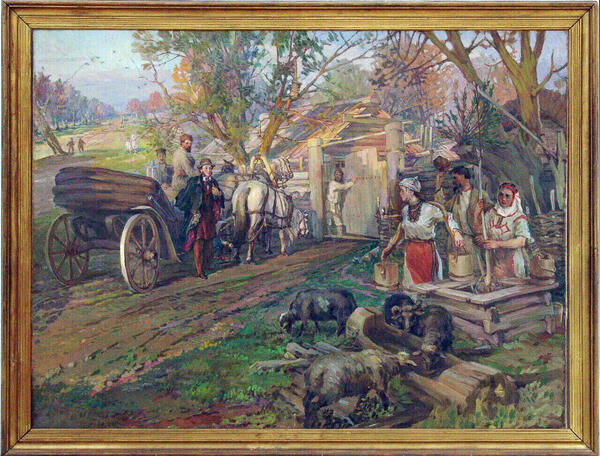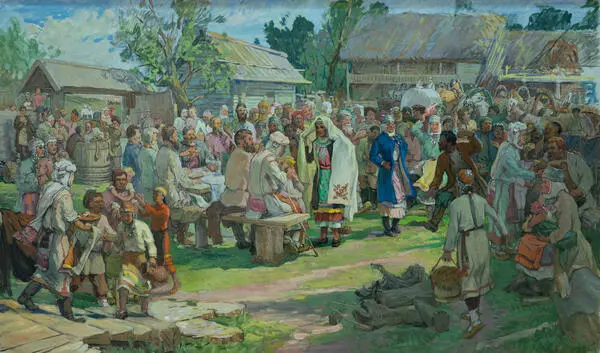The picture on display reflects a well-known historical fact: when Alexander Pushkin decided to write a book about the Pugachev’s Rebellion, he followed its traces in the Volga and Orenburg regions to collect documentary materials and eyewitness accounts of the events. On the way from Nizhny Novgorod to Kazan, Pushkin stopped in Cheboksary to change horses. He spent the night near the village of Ismeli (now the village of Oktyabrskoye, Mariinsky-Posadsky district), the next morning he reached Uslon, crossed the Volga to get to Kazan, from Kazan he went to Simbirsk and then to Orenburg.
According to eyewitnesses, in the Ismeli village, the poet met a Chuvash girl at a well and was fascinated by her figure and beauty. The peculiar rich and diverse green coloring of the picture is shown through the greenery of the oak, the moss on old wooden buildings, the freshness of grass, and the silvery white willows on a quiet village street. The very image of Pushkin is deeply psychological: the painting conveys his sudden excitement and joyful amazement at beholding the girl’s charming face. He jumps out of the carriage and sees a young Chuvash woman wearing a silver headdress and colorfully embroidered clothes, holding oak buckets, with her proud figure arched under their weight. Pushkin’s posture is dynamic as if he is moving. The driver looks back at his delighted exclamation. The characters in the painting are juxtaposed: Pushkin to the girl and the group at the carriage to the group at the well. Right between them is the owner of the residence, opening the gate for the visitors, and in the distance, one can discern the village street from where the carriage drove.
The plot presents a great combination of the past, present, and future. The chosen moment is perfect, for it allows the viewer to imagine what was before this meeting and what will happen after it. This moment provokes thoughts about how poor the people are in terms of money and yet how rich when it comes to spirituality, that the hardworking people, who preserved their national traditions, never lost their pride and sense of beauty. In this painting, Nikita Sverchkov uses the time to skillfully and truthfully reveal the rich history of his people.
According to eyewitnesses, in the Ismeli village, the poet met a Chuvash girl at a well and was fascinated by her figure and beauty. The peculiar rich and diverse green coloring of the picture is shown through the greenery of the oak, the moss on old wooden buildings, the freshness of grass, and the silvery white willows on a quiet village street. The very image of Pushkin is deeply psychological: the painting conveys his sudden excitement and joyful amazement at beholding the girl’s charming face. He jumps out of the carriage and sees a young Chuvash woman wearing a silver headdress and colorfully embroidered clothes, holding oak buckets, with her proud figure arched under their weight. Pushkin’s posture is dynamic as if he is moving. The driver looks back at his delighted exclamation. The characters in the painting are juxtaposed: Pushkin to the girl and the group at the carriage to the group at the well. Right between them is the owner of the residence, opening the gate for the visitors, and in the distance, one can discern the village street from where the carriage drove.
The plot presents a great combination of the past, present, and future. The chosen moment is perfect, for it allows the viewer to imagine what was before this meeting and what will happen after it. This moment provokes thoughts about how poor the people are in terms of money and yet how rich when it comes to spirituality, that the hardworking people, who preserved their national traditions, never lost their pride and sense of beauty. In this painting, Nikita Sverchkov uses the time to skillfully and truthfully reveal the rich history of his people.




